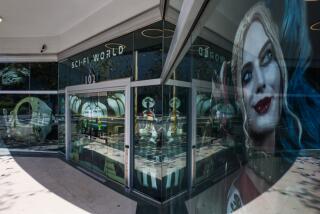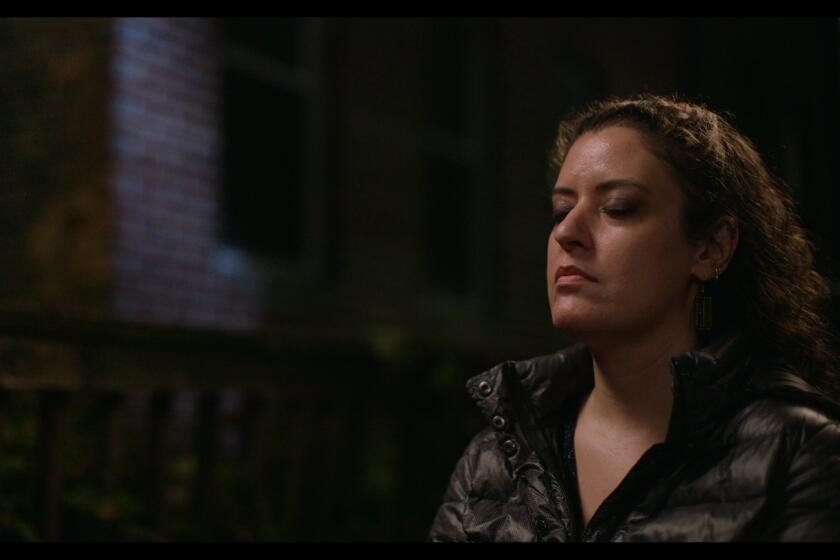Classic Hollywood: UCLA archive flashes gems to mark 50 years of film and TV preservation
“UCLA Film & Television Archive advocates the robust circulation of all moving images in all formats by collecting, preserving, curating and making accessible media for research, education and entertainment.”
— From the UCLA archive’s mission statement
Since its inception in 1965, the UCLA institution has become one of the world’s premiere archives for screen history, entertainment and education.
The archive, which is focused on the preservation, study and presentation of film and television, has more than 350,000 holdings. The organization’s Hearst Metrotone News Collection features more than 27 million feet of footage — that’s about 5,000 hours — documenting major events from 1915 to 1975.
------------
FOR THE RECORD
Sept. 21, 11:21 a.m.: In an addendum to the Classic Hollywood column published in the Sept. 20 Sunday Calendar print edition and online on Sept. 19, it was stated that the “Archive Treasures 50th Anniversary Celebration” show would run from Oct. 2 to Nov. 7. The event will run until Dec. 19. Also, the “Jean Grémillon: Le Ciel Est à Vous” event is running until Nov. 21, not Nov. 6.
------------
SIGN UP for the free Classic Hollywood newsletter >>
In the last 50 years, the archive has built a reputation for its exhibition of early silent movies, Hollywood classics, documentaries, contemporary independent films, experimental and avant-garde works and international cinema. The archive screening programs take place at the Billy Wilder Theater at the Hammer Museum in Westwood.
It all started quietly.
“The archive was officially founded in 1965, but it didn’t really get going in a significant way until about 10 years later,” said its current director, Jan-Christopher Horak. “The core collection is actually the television collection.”
The Television Academy, noted Horak, had amassed a large collection of TV programming through the 1950s and early ‘60s, and it needed a home. After the collection was given to UCLA, he said, “it basically sat here and was relatively dormant.”
Movies became part of the equation after the archive negotiated with Paramount Pictures in 1971 to deposit its pre-1948 print library with the fledgling facility. (Over the years, Warner Bros., Columbia Pictures, 20th Century Fox and Republic Pictures have deposited material with the archive too.)
Bob Rosen was named the first director of the archive in the mid-1970s. “That is when the TV collection and the film collection was unified,” said Horak.
The preservation program began in earnest in 1977 after preservation officer Bob Gitt was hired.
“Things started to come in quickly,” said Horak. “I think UCLA grew so rapidly because we were right in Hollywood. We were the only game in town,” he said, adding that the other major film and TV archives — the Museum of Modern Art, the George Eastman House and the Library of Congress — are all on the East Coast. (The Academy Film Archive in Beverly Hills wasn’t founded until 1991.)
The biennial UCLA Festival of Preservation, which showcases the classics and little-known films of the last century that the archive has restored, and the yearly Iranian festival, which celebrates contemporary and classic Iranian pictures, were established more than 20 years ago and are among the organization’s most popular offerings.
“They have always had a staff that is very passionate about what they do,” said Grover Crisp, executive vice president, asset management, film restoration and digital mastering at Sony Pictures Entertainment. “We have had a long-standing preservation/restoration relationship that dates from the late 1980s and our first meetings with Bob Rosen and [curator] Eddie Richmond. Bob and Eddie helped us establish what was probably the first public/private partnership between a major archive and a studio, and that relationship helped define our preservation goals as a company. Over the last 15 years, we were grateful to UCLA for highlighting our own work by premiering a number of our restorations.”
The archive has been celebrating this milestone throughout the year with such programming as retrospectives on directors Frank Borzage and Dorothy Arzner, which also highlighted several archive preservations.
In October and November, the archive is presenting some of its greatest hits culled from the various editions of its preservation festivals, including 1948’s “The Red Shoes,” 1946’s “Gilda,” 1935’s “Becky Sharp” and 1940’s “His Girl Friday.”
The festivities also include a celebration of Los Angeles on film.
“We have an international reputation for preserving films, but many people are probably not aware that part of our formal mission is to collect and preserve footage that documents the history and culture of Southern California and Los Angeles,” said Mark Quigley, manager of the archive’s research and study center.
In many cases, he noted, “moving images including home videos may present the best existing documentation of places and spaces that simply no longer exist or no longer exist in their original form.”
On Nov. 13 and 14, the archive is presenting a symposium, “This Is the City: Preserving Moving Images of Los Angeles,” which will feature guest speakers, screenings and discussions.
Kicking off the symposium is a screening of Franco Rossi’s 1962 Italian film “Smog.” There will be clips of Los Angeles in the 1920s, a Technicolor short from the 1930s featuring Olvera Street and a tribute to the classic local travelogue TV series “Ralph Story’s Los Angeles,” which premiered in 1964.
A film series will follow, kicking off Nov. 15 with the world premiere of Zeinabu irene Davis’ documentary “Spirits of Rebellion: Black Cinema From UCLA” and continuing through Dec. 14. Among the highlights are “Ephemera(l) City: Los Angeles in Travelogues, Industrial Films & Amateur Movies,” a look at East Los Angeles and the Chicano Moratorium of 1970, Robert Aldrich’s 1955 noir “Kiss Me Deadly,” the 1951 premiere episode of Jack Webb’s “Dragnet” and an evening of Los Angeles in the newsreels.
Noted Quigley: “Our goal is to show the full diversity of the city.”
------------
Highlights in the history of the UCLA Film & Television Archive:
Dec. 16, 1965: The archive is founded on Dec. 16, 1965.
1971: The Paramount Pictures pre-1948 print library is donated.
1981: The archive becomes the permanent home to the Hearst Metrotone News Collection.
1997: The archive and the Sundance Institute partner to create the Sundance Collection at UCLA to preserve long-term access to independent film production.
2000: The archive and the Directors Guild of America establish the DGA-Motion Picture Industry Conservation Collection of new 35-millimeter prints of films directed by guild members.
2005: The archive and Outfest partner to found the Outfest UCLA Legacy Project for LGBT Moving Image Preservation, which is now the largest publicly accessible collection of LGBT moving-image materials in the world.
2011: The archive presents a retrospective of L.A. Rebellion, the archive’s research-collection-restoration-exhibition project chronicling the accomplishments of African American students enrolled in UCLA’s School of Theater, Film and Television in the late 1960s and early ‘70s; they created a new culture of black film. A new book, “L.A. Rebellion: Creating a New Black Cinema,” is scheduled for publication this November.
------------
UCLA Film & Television Archive’s 50th anniversary programming at the Billy Wilder Theater:
“Archive Treasures 50th Anniversary Celebration,” Oct. 2 to Dec. 19
“This Is the City: Preserving Moving Images of Los Angeles” symposium and screening series:
Symposium, Nov. 13-14; screening series, Nov. 15 to Dec. 14
“Jean Grémillon: Le Ciel Est à Vous,” Oct. 17 to Nov. 21
“Outfest Legacy Project” screening series, Nov. 8 and Dec. 5
“Archive Documentary Spotlight,” Nov. 22
------------
For more Classic Hollywood, follow us on Facebook and subscribe to the newsletter.
More to Read
Only good movies
Get the Indie Focus newsletter, Mark Olsen's weekly guide to the world of cinema.
You may occasionally receive promotional content from the Los Angeles Times.











